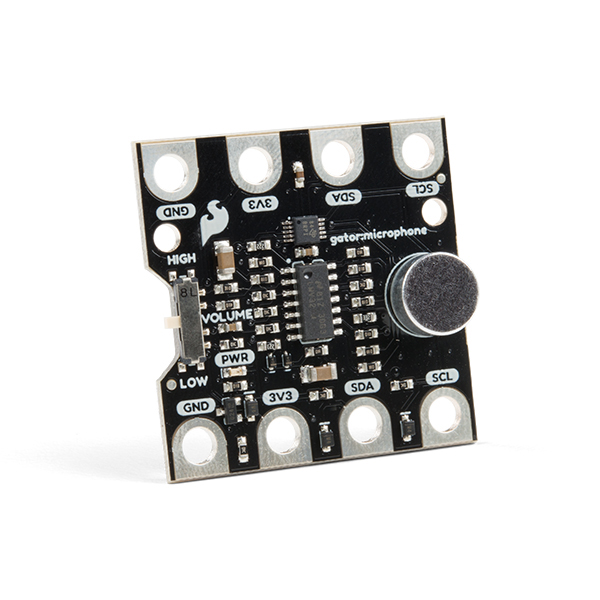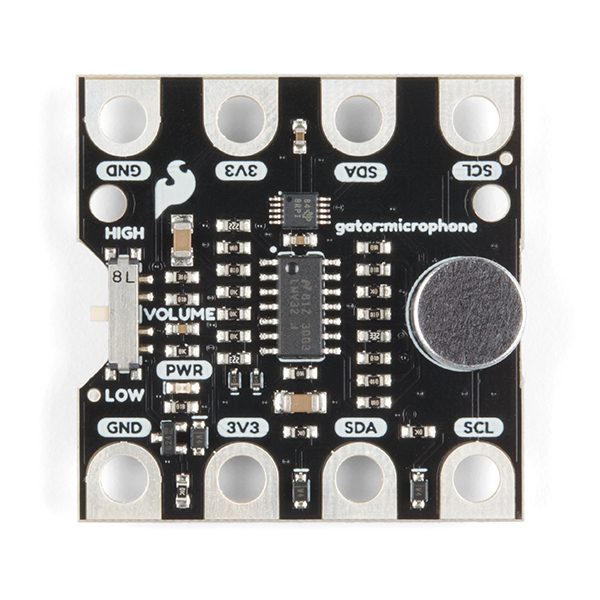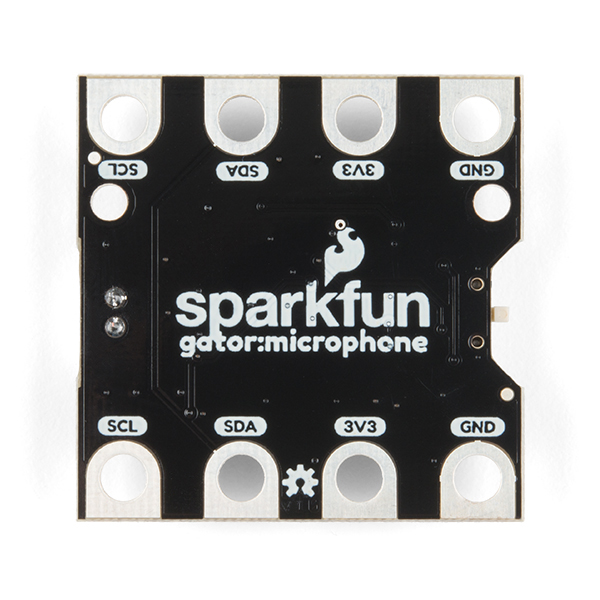SparkFun gator:microphone - micro:bit Accessory Board
The SparkFun gator:microphone is a micro:bit Accessory Board that integrates an electret microphone into SparkFun's gator:bit series of gator-clippable accessories, enabling it to be easily interfaced with the micro:bit or other microcontrollers! It provides a binary indication of the presence of sound and an analog representation of its amplitude.
The gator:microphone consists of four pads for power and data. There is also a switch on the board to select different audio amplification levels. Additionally, it includes an LMV324 operational amplifier (op-amp) for processing the audio signals from the microphone. The specified operating voltage for the VEML6070 is between 2.7V-5.5V. For use with the gator:bit (v2) and micro:bit, you should provide 3.3V through the 3V3 and GND pads to keep the logic levels consistent.
The micro:bit is a pocket-sized computer that lets you get creative with digital technology. Between the micro:bit and our shield-like bit boards you can do almost anything while coding, customizing and controlling your micro:bit from almost anywhere! You can use your micro:bit for all sorts of unique creations, from robots to musical instruments and more. At half the size of a credit card, this versatile board has vast potential!
- gator:bit Compatible
- ADS1015
- Operating Voltage (VDD): 2.0V-5.5V
- Operating Temperature: -40°C to 125°C
- Operation Modes: Single-Shot, Continuous-Conversion (Default), and Duty Cycling
- Analog Inputs:
- Measurement Type: Single-Ended (Default)
- Input Voltage Range: GND to VDD
- Full Scale Range (FSR): ±.256V to ±6.114V (Default: 2.048V)
- Resolution:
- 12-bit (Differential) or 11-bit (Single-Ended)
- LSB size: 0.125mV - 3mV (Default: 1 mV)
- Sample Rate: 128 Hz to 3.3 kHz (Default: 1600SPS)
- Current Consumption (Typical): 150μA-200μA
- I2C Address: 0x48
- Electret Microphone
- Operating Voltage: 1.5V (Max 10V)
- Supply Current: 0.3mA (Max)
- Directivity: Omnidirectional
- Frequency Response: 20-16,000Hz
- LMV324 Op-amp
- Operating Voltage: 2.7V-5.5V
- Supply Current: ~300-720µA
- Schematic
- Eagle Files
- Hookup Guide
- Datasheet (Electret Microphone)
- Datasheet (LVM324)
- Datasheet (ADS1015)
- gator:microphone PXT Package
- micro:bit Information Page
- GitHub Hardware Repo
SparkFun gator:microphone - micro:bit Accessory Board Product Help and Resources
Getting Started with the micro:bit
September 2, 2021
The BBC micro:bit is a compact, powerful programming tool that requires no software installation. Read on to learn how to use it YOUR way!
SparkFun gator:bit v2 Hookup Guide
January 31, 2019
The gator:bit v2 is a breakout board for the BBC micro:bit. The gator:bit exposes almost every pin on the micro:bit to clippable pad with circuit protection. It also has as built-in addressable LEDs and a built-in buzzer.
SparkFun gator:microphone Hookup Guide
June 13, 2019
The gator:microphone is an I2C sensor for detecting sound with an electret microphone. This tutorial will get you started using the gator:microphone with the micro:bit platform.
Core Skill: Programming
If a board needs code or communicates somehow, you're going to need to know how to program or interface with it. The programming skill is all about communication and code.
Skill Level: Rookie - You will need a better fundamental understand of what code is, and how it works. You will be using beginner-level software and development tools like Arduino. You will be dealing directly with code, but numerous examples and libraries are available. Sensors or shields will communicate with serial or TTL.
See all skill levels
Core Skill: Electrical Prototyping
If it requires power, you need to know how much, what all the pins do, and how to hook it up. You may need to reference datasheets, schematics, and know the ins and outs of electronics.
Skill Level: Rookie - You may be required to know a bit more about the component, such as orientation, or how to hook it up, in addition to power requirements. You will need to understand polarized components.
See all skill levels
Comments
Looking for answers to technical questions?
We welcome your comments and suggestions below. However, if you are looking for solutions to technical questions please see our Technical Assistance page.
Customer Reviews
No reviews yet.




